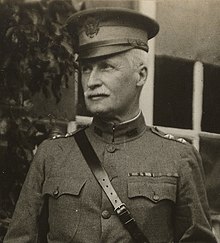Edward Mann Lewis |
|---|
 |
| Born | (1863-12-10)December 10, 1863
New Albany, Indiana, United States |
|---|
| Died | July 27, 1949(1949-07-27) (aged 85)
Oakland, California, United States |
|---|
| Place of burial | |
|---|
| Allegiance |  United States United States |
|---|
| Service/branch |  United States Army United States Army |
|---|
| Years of service | 1881 to 1928 |
|---|
| Rank | Major General |
|---|
| Service number | 0-55 |
|---|
| Commands | Fort Wood, NY Statue of Liberty
Plattsburgh, NY Old Stone Barracks
76th Infantry Brigade
38th Infantry Division
The Paris Military District
3rd Brigade, 2nd Infantry Division
30th Infantry Division
5th Infantry Division
The Douglas Arizona District
3rd Infantry Division
2nd Infantry Division
8th Corps Area
Hawaiian Division
The Hawaiian Department |
|---|
| Battles/wars | Spanish–American War
Vera Cruz
Moro Rebellion
World War I
Fourth Battle of Ypres
Somme
Hindenburg Line
Battle of St. Quentin Canal
Bellicourt
Nauroy
Vaux
Selle River Campaign |
|---|
| Awards | Distinguished Service Medal
Knight Commander of St. Michael and St. George – England
Commander Legion of Honor – France
Knight, Order of Leopold for Gallantry – Belgium
Officer of the Order of Leopold II with Palm – Belgium
Knight Commander, Order of Danilo – Montenegro
World War I Victory Medal with 5 Battle Clasps
Croix De Guerre – France (with 2 Palms)
Croix De Guerre – Belgium (with Palm)
Spanish Campaign Medal
Army of Cuban Occupation Medal
Mexican Service Medal
Philippine Campaign Medal
Society of the Army of Santiago de Cuba |
|---|
Major General Edward Mann Lewis, KCMG, (December 10, 1863 – July 27, 1949) was a highly decorated United States Army officer who served his nation for 46 years. During the First World War, he led the 30th Infantry Division when they broke the Hindenburg Line. Upon arrival in France in 1917, he was placed in command of all U.S. forces in Paris. In 1918 he led the 3rd Brigade of the 2nd Infantry Division at Château-Thierry where he was responsible for planning and leading the attack on the strategic town of Vaux. General John J. Pershing then promoted him and placed him in command of the 30th Infantry Division in July 1918. Assigned to the Fourth British Army, the 30th Division (Old Hickory) broke the Hindenburg Line on September 29, hastening the end of the Great War.
